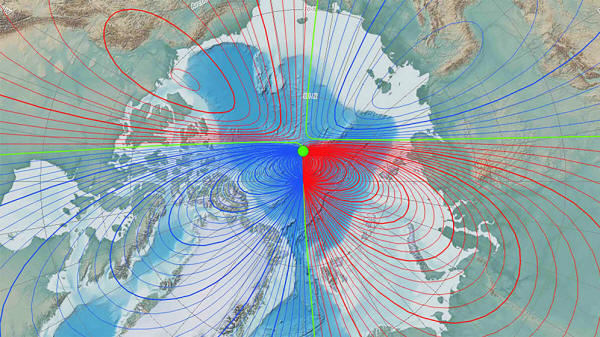|
from Undark Website
Spanish version from solar radiation is under attack from within. We can't prevent it, but we ought to prepare.
When he analyzed their magnetic properties, he was astonished at what they showed:
Today, we know that the poles have changed places hundreds of times, most recently 780,000 years ago.
(Sometimes, the poles try to reverse positions but then snap back into place, in what is called an excursion. The last time was about 40,000 years ago.)
We also know that when they flip next time, the consequences for the electrical and electronic infrastructure that runs modern civilization will be dire.
The question is when
that will happen...
It turns out that the
dipole - the orderly two-pole magnetic field our compasses respond
to - is under attack from within.
Like factions planning a coup, swirling clusters of molten iron and nickel are gathering strength and draining energy from the dipole. The north magnetic pole is on the run, a sign of enhanced turbulence and unpredictability.
A cabal in the
Southern Hemisphere has already gained the upper hand over about
a fifth of the Earth's surface. A revolution is shaping up...
Scientists can't say for
sure that is happening now - the dipole could beat back the
interlopers. But they can say that the phenomenon is intensifying
and that they can't rule out the possibility that a reversal is
beginning.
The Earth's magnetic field protects our planet from dangerous solar and cosmic rays, like a giant shield.
As the poles switch places (or try to), that shield is weakened; scientists estimate that it could waste away to as little as a tenth of its usual force. The shield could be compromised for centuries while the poles move, allowing malevolent radiation closer to the surface of the planet for that whole time.
Already, changes within
the Earth have weakened the field over the South Atlantic so much
that satellites exposed to the resulting radiation have experienced
memory failure.
Daniel Baker, director of the Laboratory for Atmospheric and Space Physics (LASP) at the University of Colorado, Boulder, one of the world's experts on how cosmic radiation affects the Earth, fears that parts of the planet will become uninhabitable during a reversal.
The dangers:
...to name just a few of the invisible forces that could harm or kill living creatures.
How bad could it be?
Scientists have never established a link between previous pole reversals and catastrophes like mass extinctions. But the world of today is not the world of 780,000 years ago, when the poles last reversed, or even 40,000 years ago, when they tried to.
Today, there are nearly 7.6 billion people on Earth, twice as many as in 1970. We have drastically changed the chemistry of the atmosphere and the ocean with our activities, impairing the life support system of the planet.
Humans have built huge cities, industries and networks of roads, slicing up access to safer living spaces for many other creatures. We have pushed perhaps a third of all known species toward extinction and have imperiled the habitats of many more.
Add cosmic and
ultraviolet radiation to this mix, and the consequences for life on
Earth could be ruinous.
The vast cyber-electric
cocoon that has become the central processing system of modern
civilization is in grave danger. Solar energetic particles can rip
through the sensitive miniature electronics of the growing number of
satellites circling the Earth, badly damaging them.
Because grids are so
tightly coupled with each other, failure would race across the
globe, causing a domino run of blackouts that could last for
decades.
And that's just for
starters...
Operators could temporarily shut down a satellite or disconnect part of the grid. But progress on learning how to track damaging space weather has not kept pace with the exponential increase in technologies that could be damaged by it.
And private satellite
operators aren't collating and sharing information about how their
electronics are withstanding space radiation, a practice that could
help everyone protect their gear.
Not only is the field turbulent and ungovernable, but, at this point, it is unpredictable. It will have its way with us, no matter what we do.
Our task is to figure
out how to make it hurt as little as possible...
|




